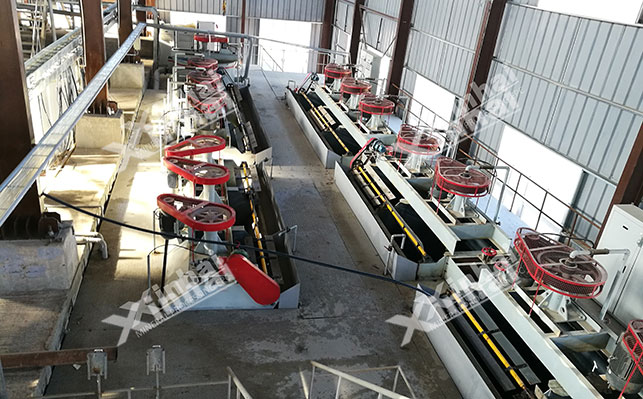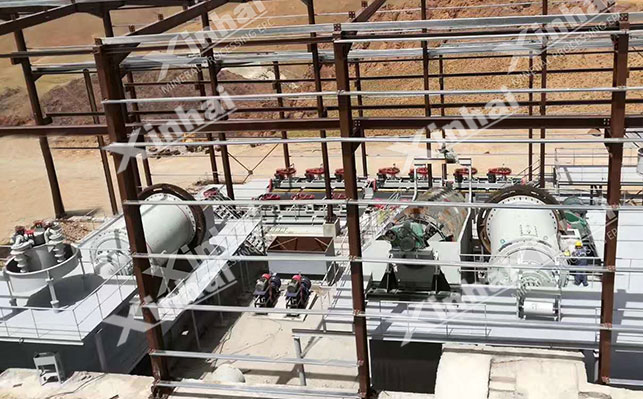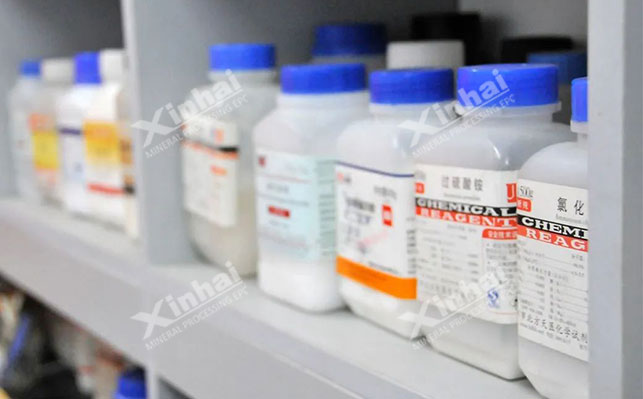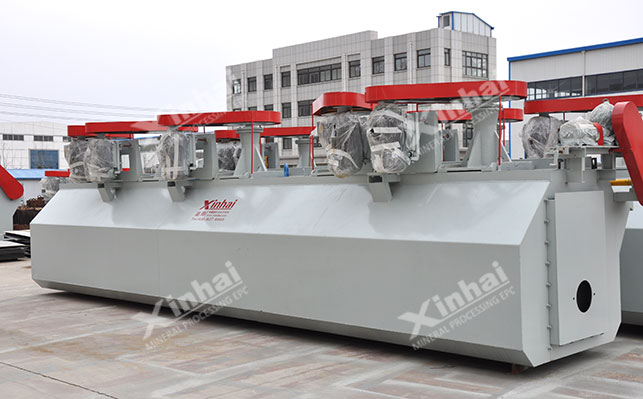
15311826613
Click to add WeChatSilver is widely used in electronics, photography, jewelry and other fields. It has high market value and has broad prospects with the development of emerging industries. As the demand for gold increases, silver also follows suit and its price rises steadily. In order to effectively obtain silver resources, it is necessary to choose a suitable silver ore dressing method. Among them, flotation is one of the commonly used methods for silver. By utilizing the surface property differences between silver and other minerals, separation can be achieved, which is suitable for the dressing of various silver ores. This article will introduce silver ore flotation, including silver ore flotation methods, processes, reagents and equipment.

The commonly used methods are single flotation method, gravity-flotation combined method, and flotation-oxidation method.
Single flotation: suitable for the dressing of various types of silver ores. It mainly utilizes the floatability of the silver ore itself and the use of reagents to achieve the separation of silver and gangue minerals. When flotating associated silver ores, it is necessary to take into account the recovery of the main metal, and preferential flotation or mixed flotation is often used.
Gravity-flotation combined method: suitable for the treatment of semi-raw silver ores and the separation of minerals with uneven silver intercalation particle size. Usually, before separation, the coarse silver particles need to be settled and enriched by gravity separation, and then the coarse concentrate is flotated and enriched.
Flotation-oxidation method: suitable for processing difficult-to-separate silver ores, such as independent silver ores and associated silver ores that are wrapped in sulfides or closely associated with gangue, with high ore dressing efficiency. Usually, most of the silver minerals are first recovered by flotation to obtain silver coarse concentrate or mixed concentrate; then they are oxidized to destroy the encapsulation relationship between silver minerals and other minerals, and then silver is leached and recovered, which can significantly improve the silver recovery rate.

Silver ore flotation process pattern The process of silver ore flotation varies depending on the type of silver ore, as follows:
Independent silver ore flotation process: The independent silver ore after mining is first crushed by a jaw crusher to reduce the particle size of large ore to 150-200mm, and then the cone crusher is finely crushed to a particle size of 25-40mm. Then it enters the ball mill for grinding, grinding to -0.074mm, accounting for 60%-80%, so that the silver minerals and gangue minerals are fully dissociated. After that, the slurry flows into the flotation machine, and collectors such as ammonium butyl black medicine are added according to the characteristics of the silver minerals, and the adjusting agent, inhibitor, and foaming agent are matched. The flotation machine is stirred and aerated, so that the silver minerals are attached to the bubbles and float to form a foam layer, and the silver rough concentrate is scraped out. Then the rough concentrate is concentrated and dehydrated to reduce the water content to complete the flotation process.
Associated silver ore flotation process: According to the requirements of mineral processing, the crushing and grinding process is customized to dissociate the monomers between the minerals, and then it is fed into the flotation machine for flotation. In the flotation stage, due to the need to take into account the recovery of the main metal, priority flotation or mixed flotation is often used. The flotation reagents and process parameters are adjusted according to the difference in mineral floatability at each stage. The concentrate dehydration stage is the same as that of independent silver ore, and then the concentrate moisture is reduced by the concentrator and filter press.
Complex silver ore flotation process: The same crushing and grinding is carried out to achieve monomer dissociation before flotation. Step-by-step flotation is adopted during flotation. First, lime is added to adjust the pH value of the pulp, and the easily floatable copper sulfide minerals and some silver minerals are floated with xanthate collectors; then sodium sulfite is added to inhibit arsenic minerals, and ethylthiocyanate is used to float lead sulfide minerals and remaining silver minerals. Subsequently, the flotation concentrate is re-selected as needed to recover coarse silver minerals and improve the enrichment degree. The re-selected concentrate is then oxidized to destroy the encapsulation relationship between silver minerals and other minerals, and then leached in the leaching tank with cyanide and other leaching agents to allow silver ions to enter the solution, and finally silver is recovered through operations such as replacement and adsorption.

In the flotation process, the selection of flotation reagents is critical, which are mainly divided into collectors, adjusters, inhibitors and frothers.
Collectors: mostly ammonium butyl black medicine, aniline black medicine, ethyl xanthate, butyl xanthate, etc. These collector molecules contain solid-philic and hydrophilic groups. The solid-philic groups can chemically adsorb with the metal ions on the surface of the silver mineral, making the silver mineral surface hydrophobic; the hydrophilic groups extend into the water, allowing the mineral particles to suspend in the water and combine with bubbles.
Adjusters: mostly lime, sodium carbonate, copper sulfate, etc., whose purpose is to adjust the pH value and ion concentration of the pulp, improve the flotation environment, and improve the flotation effect. Among them, lime can increase the pH value of the pulp and inhibit the flotation of sulfide minerals such as pyrite; copper sulfate can activate minerals such as sphalerite and improve their floatability.
Inhibitors: commonly used are sodium sulfide, sodium sulfite, starch, etc., whose purpose is to inhibit the floatability of certain minerals so that the target mineral can be better separated from other minerals.
Foaming agent: pine oil, MIBC (methyl isobutyl carbinol), etc. can be used, the purpose is to produce stable bubbles so that hydrophobic silver minerals can attach to the bubbles and float. In actual production, in order to improve the flotation effect, mixed drugs are often used, such as butyl ammonium black medicine + yellow medicine, extractant + yellow medicine, etc.

Common silver ore flotation equipment mainly includes mechanical stirring flotation machine, aerated flotation machine, flotation column, etc.
Mechanical stirring flotation machine: mainly through the high-speed rotation of the impeller to form negative pressure in the flotation tank, inhale air and disperse into tiny bubbles, the impeller stirs to fully mix the slurry and bubbles, with self-absorption of air and slurry functions, no additional aeration equipment and foam pump are required, the aeration volume and stirring intensity can be flexibly adjusted, when dealing with complex silver ores, it can accurately control the flotation parameters at different flotation stages, realize the effective recovery of a variety of silver minerals and associated minerals, and is suitable for the flotation of various types of silver ores.
Aerated flotation machine: This type of flotation machine has a separate aeration device outside to fill air into the flotation tank, reduce impeller wear, and reduce energy consumption. Its aeration volume is easy to adjust, and the size and number of bubbles can be accurately controlled to improve flotation efficiency and selectivity. It has obvious advantages when processing low-grade silver ores or silver ores with high requirements for flotation indicators. It can improve the grade of concentrate while ensuring the silver recovery rate.
Flotation column: It has a cylindrical structure. The slurry is fed from the top, and bubbles are generated from the bottom through the aeration device and move upward. The slurry and bubbles are in countercurrent contact in the column to separate the silver minerals from the gangue minerals. It has a good recovery effect on fine silver minerals. When processing complex silver ores containing a large number of fine silver minerals, compared with other flotation equipment, the countercurrent contact method of the flotation column can effectively increase the collision probability of silver minerals and bubbles, thereby improving the recovery rate of fine silver minerals.
The above is the relevant content of silver ore flotation. In actual ore dressing plants, silver ore not only has flotation methods, but also gravity separation methods, cyanidation methods, etc. The specific selection of the process depends on the properties of the silver ore. It is recommended to design a suitable silver ore dressing method through ore dressing experiments to achieve effective recovery of silver and improve the resource utilization rate of silver.